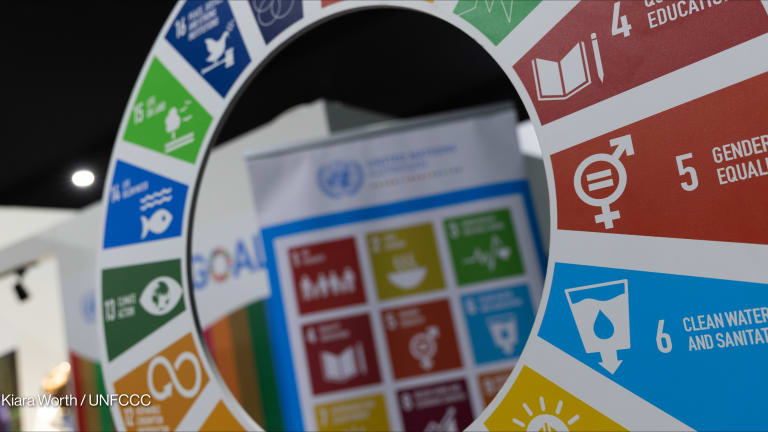
As the Millennium Development Goals come to a close at the end of the year, many in the global development community say that historic top-down development approaches have missed the mark and need a big overhaul. Technical interventions are often created and delivered without adequate attention to linkages among the root causes of poverty, some say.
“The current infrastructure, from how projects are funded to how they’re carried out, has not evolved much in 40 years and remains incredibly siloed,” said Greg Beck, director of integrated development at FHI 360. “We need a paradigm shift in the global development architecture that supports a more integrated, people-centered approach.”
Organizations like FHI 360 have acknowledged that working in silos isn’t a successful development strategy in many situations. When it comes to achieving the closely connected sustainable development goals, they believe an integrated approach may hold the key for success. And, many are calling for building more evidence around the approach.
Indeed, anecdotes highlighting the need for better integration in development approaches abound. “Take for example a typical mother in western Kenya,” said Leith Greenslade, vice chair of the MDG Health Alliance. “In the course of a year, she typically has to use three separate health care systems spread out over a wide geographic area — making multiple visits to facilities to get her HIV test, her prenatal care, and her children vaccinated. And she has to juggle all this on top of a job and myriad other household obligations. It is very costly for her to navigate this complexity and so she doesn’t — and that’s when she and her children can suffer.”
Members of the Locus Initiative
Founding partners:
FHI 360
Pact
SNV USA
Aga Khan Foundation USA
International Rescue Committee
Africa Capacity Alliance
Associate members:
Nuru International
The Hunger Project
Camaris International
Conservation International
MPoweringHealth
The MDG Health Alliance, through an internal analysis, discovered that an additional 300,000 child lives could be saved simply by delivering five basic interventions at the same time and place, to just nine populations. “The failure to integrate the delivery of our most effective vaccines, diagnostic tests and medicines is one of the reasons we have not achieved MDGs 4 and 5,” said Greenslade.
Many organizations echo the need for more integrated services, including Locus, a coalition focused on promoting evidence-based, local solutions to development challenges. According to Mark Viso, CEO of PACT and a founding member of Locus, “Integrated development approaches, by leveraging interdependencies and addressing complex problems at a systems level, can potentially transform people’s lives.”
Sustainable development goals: Ambitious and integrated agenda
The new SDGs, slated to be ratified by the U.N. General Assembly this month, set an ambitious agenda to accelerate human development comprehensively. The 17 SDG goals and 169 indicators build on the MDGs but are more expansive in scope and, as stated in the U.N. member state outcome document, “are integrated and indivisible, and balance the three dimensions of sustainable development: the economic, social and environmental.”
According to Tony Pipa, U.S. special coordinator for the post-2015 Development Agenda, “The SDGs challenge countries to think about and make progress on multiple dimensions of poverty reduction and environmental sustainability at once and holistically.”
The concept of integrated development is not new, having been used in the 1970s and 1980s in rural agricultural development with mixed results. While no single definition exists, FHI 360 defines integrated development as “an intentional approach that links the design, delivery and evaluation of programs across disciplines and sectors to produce an amplified, lasting impact on people's lives.”
And while this framing makes sense intuitively, the research is thin on when, under what circumstances and how best to implement such an approach. For example, in its 2014 literature review Integration of Global Health and Other Development Sectors, FHI 360 found that there were very few studies designed rigorously enough to test whether there were additive benefits of integrated development, and of the 25 programs that did measure this adequately, almost half showed mixed or no benefits.
“The existing evidence demonstrates strong linkages among determinants of well-being but isn’t clear on how to achieve better outcomes,” said Beck. “We need more rigorous data to understand when and how integrated approaches are most effective and cost-efficient, and under what circumstances they aren’t.”
Getting clear on the evidence is critical, particularly considering the potential challenges associated with shifting approaches, the pressure of shrinking funding, and donors’ expectations around measurable results. An integrated approach can increase the complexity, time and resource investment of a project for delivery organizations, and might be viewed as a distraction to reaching goals. “Organizations are structured around particular areas of technical expertise so integrating is tough; it’s a real business challenge” said Viso. “Donors don’t fund this way, and we don’t yet have shared metrics to measure progress and proved additive impact or cost-benefit.”
Proof of concept: Filling the evidence gap
To help fill this evidence gap, FHI 360 is dedicating $4 million through an FHI Foundation grant as part of its Clinton Global Initiative commitment to explore to what degree combined efforts produce an amplified impact in communities and are cost-effective. “Because integrated development approaches can come in endless combinations, it’s difficult to generalize what works and doesn’t or to prove when integrating has amplified impact,” said Tricia Petruney, technical advisor in Research Utilization at FHI 360.
The organization will use the research findings to develop tools for practitioners to better understand how to integrate projects and measure effectiveness.
“Because the approaches are so varied, we can’t come up with a guidebook that fits every scenario. But we can define key questions that people should answer in every single context, a kind of algorithm for success,” said Petruney.
In addition to this research FHI 360 is creating a Web-based integrated impact index that will allow practitioners to better measure results of integrated projects. They are also evaluating their portfolio of over 70 integrated projects to measure their own effectiveness. “Research like this can be quite useful to practitioners and donors alike,” said Pipa. “We need to show which interventions are having what impacts, what the return on investment is, where the innovations are, and what models are working that we can scale up.”
Ultimately, FHI 360 and its partners hope that their efforts will break down silos and change the conversation within the global development community so that progress on the SDGs can be accelerated. As Beck said, “Our solutions should be as interconnected as the problems we seek to solve.”
How can an intentional, integrated approach to the design, delivery and evaluation of programs make an enduring difference in people’s lives? Devex, in partnership with FHI 360, aims to advance the global conversation on the promise offered by integrated development solutions through #IntegratedDev. Visit the campaign site and join the conversation using #IntegratedDev.








